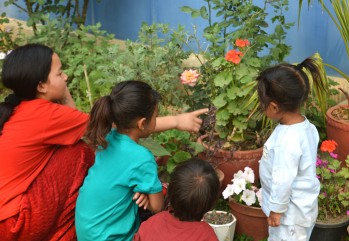

Finding Hope Amidst Challenges
By Chora Chori Nepal
In the rural regions of Nepal, numerous young girls bear the burden of trafficking, violence, and early marriage, often lacking education, adequate nutrition, and even basic provisions. Establishing a strong foundation for them is vital to securing children’s future. Recently, Chora Chori Nepal confronted a similar distressing case.
A week ago, Chora Chori Nepal received a call from one of the Ward offices of Hetauda Municipality regarding a missing child. We promptly relayed this information to the National Child Rights Council (NCRC), who then forwarded it to the National Centre for Child at Risk (NCCR) 104. At the same time, we learned that the missing child was the youngest sister of one of our beneficiaries, Priya (all names changed). Priya, just 11 years old, was rescued from a child marriage situation a few months ago and has been residing here ever since.
Priya's parents have seven children in total. The eldest daughter is married, and the two elder brothers are in Kathmandu working as laborers. Below Priya are two younger sisters, aged 10 and 2.5 years, and a 5-year-old brother. The missing child case came to light when Priya's mother returned home from Kathmandu without her youngest daughter, Priti. Suspicious neighbors reported this, probing the local police to investigate. Then the mother was taken into police custody for investigation; where she admitted to giving Priti to a friend named Urmila to keep in a hostel in Kathmandu, thinking it will be a good arrangement for better education and necessities, similar to Priya's situation.
Following the mother's arrest, the father's whereabouts remained unknown, leaving the two younger children alone at home and at risk. The friend Priti’s mother referred to in the investigation, initially known as Urmila, turned out to be Kalpana while tracing; who claimed that the mother handed Priti to her for better care and education.
Tracing Kalpana's whereabouts proved challenging; although she agreed to hand Priti over to CCN’s staff, but she was nowhere to be found at the given time and date and also switched her phone off. While tracing her number, she was located in the border area of Nepal and India, raising concerns whether the child had been abducted or trafficked across the border. However, the next day, Priti was rescued.
Despite Kalpana's attempts to persuade CCN staff to drop the case, CCN along with NCCR 104 and Nepal police, successfully rescued Priti from Kalpana. Her story unfolded: Kalpana took the child from the mother and then passed Priti to a woman named Rita in Jhapa for an illegal adoption, as Rita was childless. The investigation continues, with Kalpana handed over to the Nepal Anti-Trafficking Bureau, while Priti and her siblings were placed under CCN’s care.
In the latest development, other mediators involved were also ordered to appear before the court. Among them was a man from the same village who facilitated the meeting between Kalpana and Priti's parents, unaware of Kalpana’s intentions. Further investigation revealed that Kalpana had been visiting the village for the past seven months to build good communication among the villagers, in which she was successful.
After initial investigations, the mediator and the mother of the child have been sent back to their respective homes as they both seemed innocent. The case has been formally filed in the district court, with the accused remaining in custody; further investigation is being conducted by the police as the legal process unfolds. Meanwhile, all four siblings are under the CCN’s care. Given the vulnerable situation in their village, CCN has taken on the responsibility for the time being.
To prevent such horrifying cases in the future, it's imperative for villages to prioritize awareness and safety measures. Communities must be cautious, ensuring that unfamiliar individuals are reported to the authorities. Equally important is educating parents about safeguarding their children's well-being. By fostering a culture of awareness and proactive protection, we can work together to create safer environments where every child can thrive.